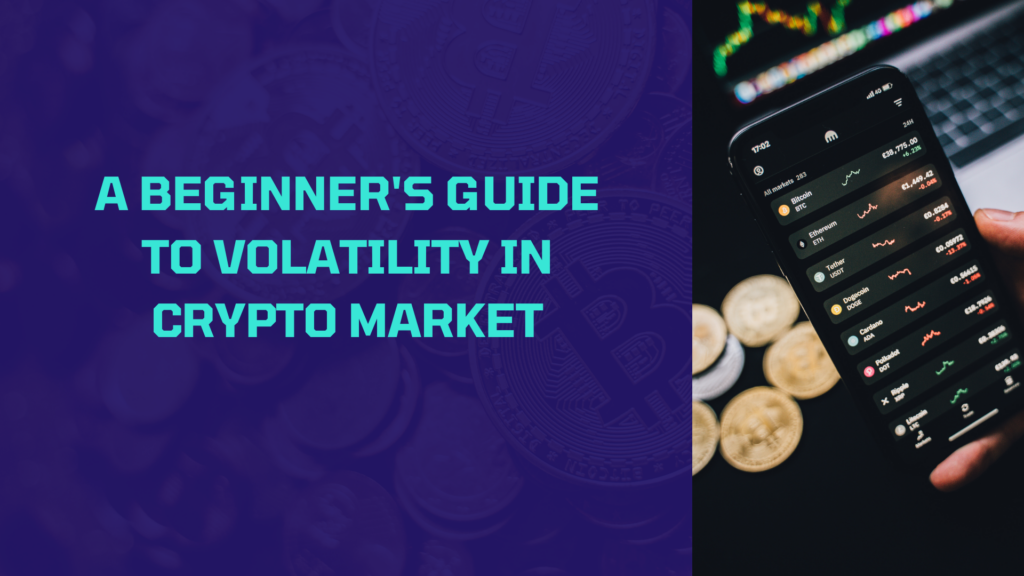A Beginner’s Guide to Volatility in Crypto Market
Introduction: Why Volatility Matters in Crypto
Volatility is the heartbeat of the cryptocurrency market. It drives price surges, dramatic drops, and trader excitement. But for newcomers, crypto market volatility can be intimidating—sometimes even paralyzing. Understanding how it works and how to handle it is crucial for anyone entering the world of digital assets.
In this guide, we’ll break down what volatility in crypto markets means, what causes it, how to manage risk, and how you can turn volatility into an advantage rather than a fear.
What is Volatility in Crypto Markets?
Volatility refers to the rate at which the price of an asset increases or decreases over a given period. The higher the volatility, the more unpredictable the asset. In the crypto market, it’s common to see price movements of 10–30% within a single day, a level of movement rarely seen in traditional markets like stocks or commodities.
Volatility in crypto is measured using standard deviation or Average True Range (ATR). These indicators show how much the price of a coin fluctuates over time.
Why Is the Crypto Market So Volatile?
Several factors contribute to the extreme price fluctuations in cryptocurrencies:
1. Speculation
Crypto markets are largely driven by speculative trading. Many traders buy assets based on trends, hype, or fear of missing out (FOMO), not fundamentals.
2. Low Liquidity
Compared to traditional markets, many cryptocurrencies have relatively low trading volumes. This means even modest trades can cause significant price swings.
3. Regulatory News
When a country announces crypto bans or introduces favorable legislation, prices can skyrocket or plummet within hours.
4. Market Sentiment
Social media posts, influential figures (like Elon Musk), and trending hashtags can greatly influence investor sentiment, which directly affects prices.
5. Technological Developments
Upgrades, forks, or protocol exploits can cause immediate price changes. For example, Ethereum’s Merge significantly influenced market sentiment in 2022.
How to Measure Crypto Volatility
Volatility Indexes
Some platforms offer crypto volatility indexes similar to the VIX for stocks. They track how uncertain or risky the market feels at any given time.
Technical Indicators
Traders often use tools like:
- Bollinger Bands
- ATR (Average True Range)
- Standard Deviation
These tools can identify breakout potential, risk levels, and trend reversals.
How Volatility Affects Different Types of Traders
Day Traders
They thrive on volatility. Sudden price swings can lead to profitable short-term trades—if the trader manages risk properly.
Long-Term Investors
Volatility presents opportunities to buy during dips. However, it also demands patience and emotional control during market downturns.
Scalpers
They profit from tiny price movements within minutes or seconds. For scalpers, volatility is essential for profitability.
Volatility in Bull vs. Bear Markets
Bull Market Volatility
Volatility in bull markets often results in sharp upward moves, followed by minor pullbacks. Optimism and FOMO dominate the narrative.
Bear Market Volatility
In bear markets, volatility often means price crashes, panic selling, and negative sentiment. These conditions can wipe out unprepared traders.
Understanding the type of market you’re in helps shape expectations and strategies.
How to Manage Volatility Risk
If you’re new to crypto, volatility might feel like chaos. Here’s how to stay calm and make smart decisions.
1. Use Stop-Loss and Take-Profit Orders
These orders automate your exits, helping to protect profits or minimize losses. Never trade without defining your risk threshold.
2. Don’t Overleverage
Many traders lose money because they use high leverage in volatile conditions. Even small price swings can liquidate over-leveraged positions.
3. Diversify Your Portfolio
Avoid putting all your capital into one asset. Spread your risk across different projects, sectors, or even blockchains.
4. Practice Dollar-Cost Averaging (DCA)
DCA reduces the emotional impact of market fluctuations. By investing fixed amounts over time, you smooth out your entry prices.
5. Stay Emotionally Disciplined
Panic selling and FOMO buying are emotional reactions that volatility amplifies. Have a clear plan and stick to it.
How to Profit From Crypto Volatility
Not all volatility is bad. In fact, it creates opportunities for those who know how to navigate it.
1. Swing Trading
Take advantage of medium-term trends. Swing trading works well in a volatile environment because of the frequent ups and downs.
2. Arbitrage Trading
Price differences between exchanges can be larger during volatile periods. Arbitrageurs profit by buying low on one platform and selling high on another.
3. Volatility Farming
Some DeFi protocols reward users for providing liquidity in high-volatility pools. However, impermanent loss must be considered.
Real-World Examples of Volatility in Action
- Bitcoin’s 2020–2021 Rally: BTC went from $10K to $64K in under a year, then dropped to $30K within two months.
- LUNA/UST Crash (2022): Terra’s stablecoin lost its peg, wiping out billions of dollars and causing market-wide panic.
- Dogecoin’s Rise in 2021: Tweets from Elon Musk drove DOGE from fractions of a cent to over $0.70 in a few months.
These events highlight how fast market dynamics can change and why managing volatility is essential.
Tools to Track and Analyze Volatility
Websites and Platforms
- TradingView — Offers indicators like Bollinger Bands and ATR.
- CoinMarketCap & CoinGecko — Provide historical price data and volatility charts.
- Glassnode & Santiment — On-chain analytics tools that track market behavior and sentiment.
Volatility Indicators to Watch
- Fear & Greed Index — Measures overall market sentiment.
- Funding Rates — Indicate leverage in the market and potential for liquidations.
- Open Interest — Shows how much capital is locked in futures contracts.
Final Thoughts: Should You Fear or Embrace Crypto Volatility?
Volatility is part of the crypto DNA. It can be dangerous or profitable, depending on how you approach it. Instead of fearing volatility, learn to respect it and work with it. Successful crypto investors and traders understand that volatility isn’t the enemy—it’s the landscape in which the game is played.
Whether you’re trading or holding, understanding crypto volatility will make you a more confident and prepared participant in the digital asset economy.
